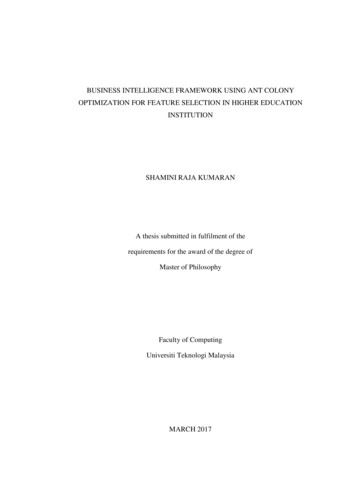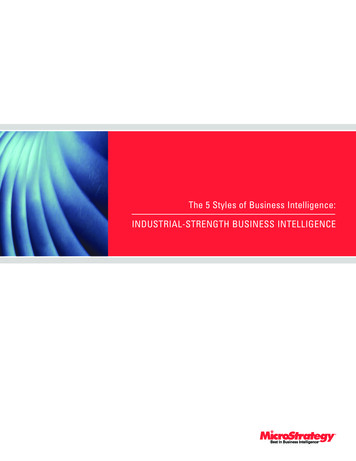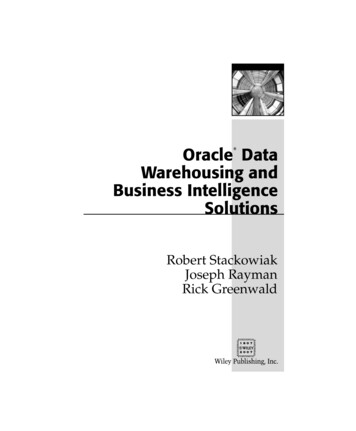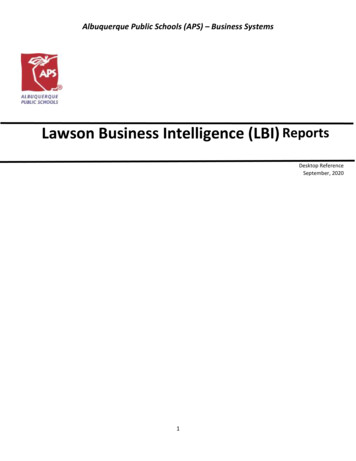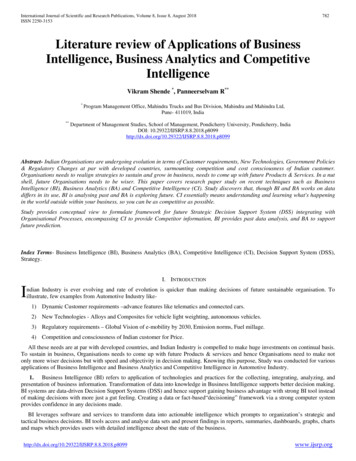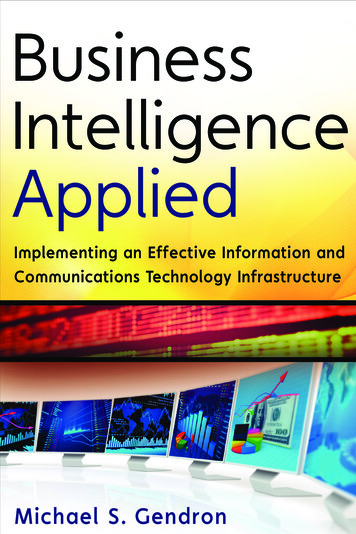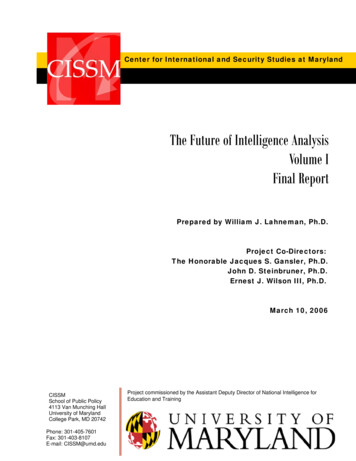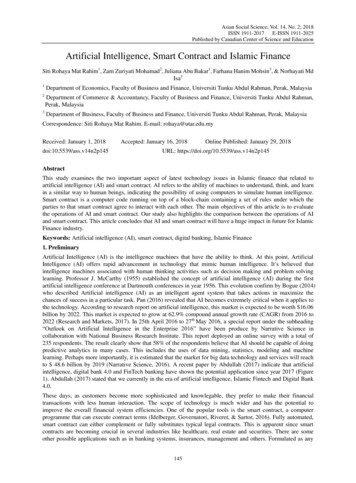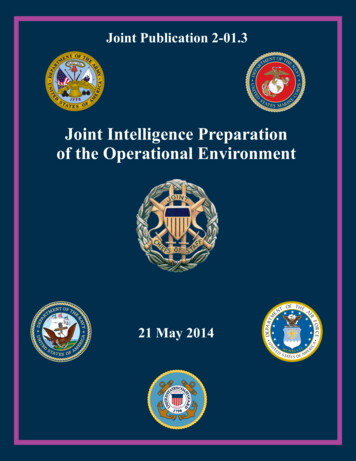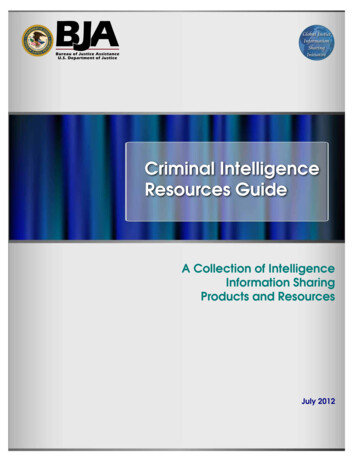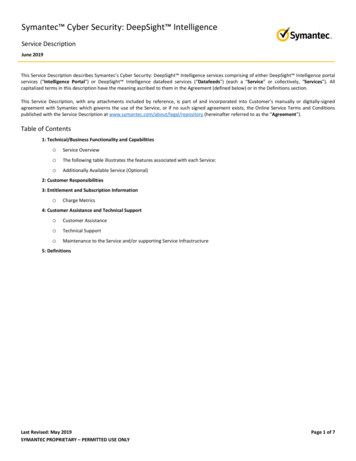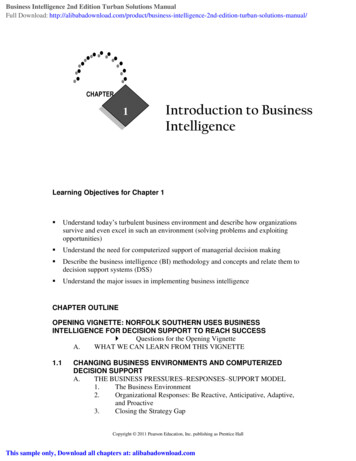
Transcription
Business Intelligence 2nd Edition Turban Solutions ManualFull Download: 1Introduction to BusinessIntelligenceLearning Objectives for Chapter 1 Understand today’s turbulent business environment and describe how organizationssurvive and even excel in such an environment (solving problems and exploitingopportunities) Understand the need for computerized support of managerial decision making Describe the business intelligence (BI) methodology and concepts and relate them todecision support systems (DSS) Understand the major issues in implementing business intelligenceCHAPTER OUTLINEOPENING VIGNETTE: NORFOLK SOUTHERN USES BUSINESSINTELLIGENCE FOR DECISION SUPPORT TO REACH SUCCESS Questions for the Opening VignetteA.WHAT WE CAN LEARN FROM THIS VIGNETTE1.1CHANGING BUSINESS ENVIRONMENTS AND COMPUTERIZEDDECISION SUPPORTA.THE BUSINESS PRESSURES–RESPONSES–SUPPORT MODEL1.The Business Environment2.Organizational Responses: Be Reactive, Anticipative, Adaptive,and Proactive3.Closing the Strategy GapCopyright 2011 Pearson Education, Inc. publishing as Prentice HallThis sample only, Download all chapters at: alibabadownload.com
2Business Intelligence (2nd Edition) Instructor’s Manual Section 1.1 Review Questions1.2A FRAMEWORK FOR BUSINESS INTELLIGENCE (BI)A.DEFINITIONS OF BIB.A BRIEF HISTORY OF BIC.THE ARCHITECTURE OF BI1.Data Warehousing2.Business Analytics Application Case 1.1: Location, Location, Location3.Business Performance Management4.The User Interface: Dashboards and Other InformationBroadcasting ToolsE.STYLES OF BIF.THE BENEFITS OF BI Application Case 1.2: Alltel Wireless: Delivering the RightMessage, to the Right Customers, at the Right TimeG.AUTOMATED DECISION MAKING (ADS) Application Case 1.3: Giant Food Stores Prices the EntireStoreG.EVENT DRIVEN ALERTS Section 1.2 Review Questions1.3INTELLIGENCE CREATION AND USE AND BI GOVERNANCEA.A CYCLICAL PROCESS OF INTELLIGENCE CREATION AND USEB.INTELLIGENCE AND ESPIONAGE Section 1.3 Review Questions1.4TRANSACTION PROCESSING VERSUS ANALYTIC PROCESSING Section 1.4 Review Questions1.5SUCCESSFUL BI IMPLEMENTATIONA.B.THE TYPICAL BI USER COMMUNITYAPPROPRIATE PLANNING AND ALIGNMENT WITH BUSINESSSTRATEGY1.6MAJOR TOOLS AND TECHNIQUES BUSINESS INTELLIGENCEA.THE TOOLS AND TECHNIQUESB.SELECTED BI VENDORS Section 1.6 Review Questions1.7PLAN OF THE BOOKA.CHAPTER 1: INTRODUCTION TO BUSINESS INTELLIGENCEB.CHAPTER 2: DATA WAREHOUSINGC.CHAPTER 3: BUSINESS PERFORMANCE MANAGEMENTD.CHAPTER 4: DATA MINING FOR BUSINESS INTELLIGENCECopyright 2011 Pearson Education, Inc. publishing as Prentice Hall
Business Intelligence (2nd Edition) Instructor’s ManualE.F.1.83CHAPTER 5: TEXT AND WEB MININGCHAPTER 6: REALITY MINING Application Case 1.4: The Next NetRESOURCES, LINKS, AND THE TERADATA UNIVERSITY NETWORKCONNECTIONA.RESOURCES AND LINKSB.CASESC.VENDORS, PRODUCTS, AND DEMOSD.PERIODICALSE.THE TERADATA UNIVERSITY NETWORK CONNECTIONF.THE BOOK’S WEB SITEChapter HighlightsKey TermsQUESTIONS FOR DISCUSSIONExercisesTeradata Student Network (TSN) and Other Hands-On ExercisesTeam Assignments and Role-PlayingInternet Exercises End of Chapter Application Case: Vodafone Uses BusinessIntelligence to Improve Customer Growth and Retention Plans Questions for the CaseReferencesTEACHING TIPS/ADDITIONAL INFORMATION The purpose of any introductory chapter is to motivate students to be interested in theremainder of the course (and book). The real-life cases, beginning with Norfolk Southernand continuing with the others, will show students that business intelligence is not just anacademic subject; it is something real companies use that makes a noticeable differenceto their bottom line. So, try to relate the subject matter to these cases. For example,consider the types of actions managers take to counter pressures. The text says thatNorfolk Southern used BI “for Decision Support to Reach Success.” The other cases inthe chapter, while not tied directly to this list, still have many examples of managerialactions taken in response to pressure. By referring back to this list when discussing othercases, you demonstrate the unity of the decision support field.All this should show students that a new professional who understands how informationsystems can support decision making, and can help his or her employer obtain thosebenefits, has a bright career path. Since students in this course are typically within a yearof graduation, that will get their attention!Copyright 2011 Pearson Education, Inc. publishing as Prentice Hall
4Business Intelligence (2nd Edition) Instructor’s ManualANSWERS TO END OF SECTION REVIEW QUESTIONS Opening Vignette Review Questions1.How are information systems used at Norfolk Southern to support decisionmaking?Norfolk Southern has always used a variety of sophisticated systems to run itsbusiness. Becoming a scheduled railroad, however, required new systems thatwould first use statistical models to determine the best routes and connections tooptimize railroad performance, and then apply the models to create the plan thatwould actually run the railroad operations. These new systems were called TOP,short for Thoroughbred Operating Plan; TOP was deployed in 2002.An enterprise data warehouse (EDW) makes data available to the applicationsused in departments throughout the organization—including engineering, humanresources (HR), and strategic planning.2.What type of information is accessible through the visualization applications?Norfolk Southern built a TOP dashboard application that pulls data from theenterprise data warehouse and then graphically depicts actual performance againstthe trip plan for both train performance and connection performance. Theapplication uses visualization technology so that field managers can more easilyinterpret the large volumes of data (e.g., there were 160,000 weekly connectionsacross the network).3.What type of information support is provided through AccessNS?AccessNS allows more than 14,500 users from 8,000 customer organizations tolog in and access predefined and custom reports about their accounts at any time.Users can access current data, which is updated hourly, or they can look at datafrom the past 3 years. accessNS provides alerting and RSS feed capabilities4.How does Norfolk Southern use the data warehouse for HR applications?Recently, the HR needed to determine where to locate its field offices in order tobest meet the needs of Norfolk Southern’s 30,000 employees. By combiningemployee demographic data (e.g., zip codes) with geospatial data traditionallyused by the Engineering Group, HR was able to visually map out the employeepopulation density, making it easier to determine the best (optimal) locations forthe field offices.Can the same data warehouse be used for business intelligence andoptimizationapplications?Copyright 2011 Pearson Education, Inc. publishing as Prentice Hall
Business Intelligence (2nd Edition) Instructor’s ManualYes. The enterprise data warehouse (EDW) makes data available to all systemsand applications. Norfolk Southern was the first railroad to offer self-servicebusiness intelligence, and its innovation is setting an example that other railroadshave followed.Section 1.1 Review Questions1.List the components of and explain the Business Pressures–Responses–Supportmodel.The components of the pressure-response-support model are business pressures,companies’ responses to these pressures, and computerized support. The modelsuggests that responses are made to counter the pressures or to take advantage ofopportunities, support facilitates monitoring the environment (e.g., foropportunities) and enhances the quality of the responses.2.What are the major factors in today’s business environment?The major factors in today’s business environment are:3. Market-related: strong competition, expansion of global markets,electronic markets blooming on the Internet, innovative marketingmethods, opportunities for outsourcing with IT support, and need for realtime on-demand transactions Consumer demand-related: the desire for customization, quality,diversity of products, and speed of delivery; more powerful and less loyalcustomers. Technology-related: more innovations, new products and services,obsolescence rate is increasing, information overload is increasing Societal: growth of government regulations and deregulation, work forcebecoming more diversified, older, and composed of more women;homeland security and terrorist attacks are prime concerns; compliancewith the Sarbanes-Oxley Act and other reporting-related legislation is amust; social responsibility of companies is increasingWhat are some of the major response activities organizations take?Responses taken by organizations include the following reactive, anticipative,adaptive and proactive activities: Employing strategic planningCopyright 2011 Pearson Education, Inc. publishing as Prentice Hall5
6Business Intelligence (2nd Edition) Instructor’s Manual Using new and innovative business models Restructuring of business processes Participating in business alliances Improving corporate information systems Improving partnership relationships Encouraging innovation and creativity Improving customer service and relationships Moving to electronic commerce (e-commerce) Moving to make-to-order production and on-demand manufacturing andservices Using new IT to improve communication, data access (discovery ofinformation) and collaboration Responding quickly to competitors’ actions (e.g., in pricing, promotions,new products and services) Automating many tasks of white-collar employees Automating certain decision processes especially those dealing withcustomers Improving decision makingSince the question reads “some,” a correct answer need not list all of these.Section 1.2 Review Questions1.Define BI.Business Intelligence (BI) is an umbrella term that combines architectures, tools,databases, applications, and methodologies. Its major objective is to enableinteractive access (sometimes in real time) to data, enable manipulation of thesedata, and provide business managers and analysts the ability to conductappropriate analysis.2.List and describe the major components of BI.Copyright 2011 Pearson Education, Inc. publishing as Prentice Hall
Business Intelligence (2nd Edition) Instructor’s Manual7BI systems have four major components: the data warehouse (analogous to thedata in the DSS architecture), business analytics and business performancemanagement (together, analogous to models in the DSS architecture), and the userinterface (which corresponds to the component of the same name in the DSSarchitecture). One could also list the user as a component.3.Identify some typical applications of BI.Typical applications of BI are data mining, forecasting, predictive marketing,optimization, and business performance management (BPM).4.Give examples of ADS.A relatively new approach to supporting decision making is called automateddecision systems (ADS), also known as decision automation systems (DAS; seeDavenport and Harris, 2005). An ADS is a rule-based system that provides asolution, usually in one functional area (e.g., finance, manufacturing), to aspecific repetitive managerial problem, usually in one industry. Examples aredeciding whether to approve or not to approve a request for a loan, or determiningthe price of an item in a store.Application Case 1.3 shows an example of applying ADS to a problem that everyorganization faces—how to price its products or services.ADS initially appeared in the airline industry, where they were called revenue (oryield) management (or revenue optimization) systems. Airlines use these systemsto dynamically price tickets based on actual demand. Today, many serviceindustries use similar pricing models. In contrast with management scienceapproaches, which provide a model-based solution to generic structured problems(e.g., resource allocation, inventory level determination), ADS provide rule-basedsolutions.5.Give examples of event-driven alerts.One example of ADS is an event-driven alert, which is a warning or action that isactivated when a predefined or unusual event occurs. For example, credit cardcompanies have built extensive predictive analysis models to identify cases ofpossible fraud and automatically alert credit card customers for verification oftransactions when unusual activity is noted (e.g. large purchase in an atypical orforeign location when the customer does not have a history of such transactions).Copyright 2011 Pearson Education, Inc. publishing as Prentice Hall
8Business Intelligence (2nd Edition) Instructor’s ManualSection 1.3 Review Questions1.List the steps of intelligence creation and use?See Figure 1.5 for the process and steps of Intelligence creation and use.2.What is BI governance?Some organizations refer to the project prioritization process as a form of BIgovernance (Matney and Larson, 2004). A major governance issue is who shouldserve as decision makers involved in prioritizing BI projects. The two criticalpartnerships required for BI governance are: (1) a partnership between functionalarea heads and/or product/service area leaders (Middles), and (2) a partnershipbetween potential Customers and Providers (representatives of the business sideand representatives from the IT side).3.What is intelligence gathering?Modern companies must ethically and legally organize themselves to glean (learn)as much as they can from their customers, their business environment, theirstakeholders, their business processes, their competitors, and other such sourcesof potentially valuable information. But collecting data is just the beginning. Vastamounts of that data need to be cataloged, tagged, analyzed, sorted, filtered, andmust undergo a host of other operations to yield usable information that canimpact decision making and improve the bottom line. The importance of thesetopics increases every day as companies track and accumulate more and moredata.Section 1.4 Review Questions1.Define OLTP.OLTP (online transaction processing) is a type of computer processing where thecomputer responds immediately to user requests. Each request is considered to bea transaction, which is a computerized record of a discrete event, such as thereceipt of inventory or a customer order.2.Define OLAP.OLAP (online analytical processing) is processing for end-user ad hoc reports, queries, andanalysis.Copyright 2011 Pearson Education, Inc. publishing as Prentice Hall
Business Intelligence (2nd Edition) Instructor’s Manual9Separating the OLTP from analysis and decision support provided by OLAPenables the benefits of BI that were described earlier and provides for competitiveintelligence and advantage as described next.Section 1.5 Review Questions1.Describe the major types of BI users.BI may have a larger and more diversified user community. One of the mostimportant aspects of a successful BI is that it must be of benefit to the enterpriseas a whole. This implies that there are likely to be a host of users in theenterprise—many of whom should be involved from the outset of a DWinvestment decision.Not surprisingly, there are likely to be users who focus at the strategic level andthose who are more oriented to the tactical level.2.List some of the implementation topics addressed by Gartner’s report.One framework, developed by Gartner, Inc. (2004), decomposes planning andexecution into business, organization, functionality, and infrastructurecomponents. At the business and organizational levels, strategic and operationalobjectives must be defined while considering the available organizational skills toachieve those objectives. Issues of organizational culture surrounding BIinitiatives and building enthusiasm for those initiatives and procedures for theintra-organizational sharing of BI best practices must be considered by uppermanagement—with plans in place to prepare the organization for change.3.List some other success factors of BI.If the company’s strategy is properly aligned with the reasons for DW and BIinitiatives, and if the company’s IS organization is or can be made capable ofplaying its role in such a project, and if the requisite user community is in placeand has the proper motivation, it is wise to start BI and establish a BI CompetencyCenter (BICC) within the company. The center could serve some or all of thefollowing functions (Gartner, 2004). The center can demonstrate how BI is clearly linked to strategy andexecution of strategy. A center can serve to encourage interaction between the potential businessuser communities and the IS organization.Copyright 2011 Pearson Education, Inc. publishing as Prentice Hall
10Business Intelligence (2nd Edition) Instructor’s Manual The center can serve as a repository and disseminator of best BI practicesbetween and among the different lines of business. Standards of excellence in BI practices can be advocated and encouragedthroughout the company. The IS organization can learn a great deal through interaction with the usercommunities such as knowledge about the variety of types of analyticaltools that are needed. The business user community and IS organization can better understandwhy the data warehouse platform must be flexible enough to provide forchanging business requirements. It can help important stakeholders like high-level executives see how BIcan play an important role.Another important success factor of BI is its ability to facilitate a real-time, ondemand agile environment.3. Why is it difficult to justify BI applications?This is not an easy task due to the large number of intangible benefits.Both direct and intangible benefits need to be identified. Of course, this is where theknowledge of similar applications in other organizations and case studies is extremelyuseful. For example, the Data Warehousing Institute (tdwi.org/) provides a wealth ofinformation about products and innovative applications and implementations. Suchinformation can be useful in estimating direct and indirect benefits.Section 1.6 Review Questions1.List the six major categories of decision support tools.The six major categories are: data management, reporting status tracking,visualization, strategy and performance management, business analytics, socialnetworking.2.Identify some companies that are major vendors in BI.Recently there has been a major surge in BI software and application providers.Some of these company names will become quite familiar after completing thisbook: Teradata, MicroStrategy, Microsoft, IBM Cognos SPSS, SAP BusinessObjects, Oracle Hyperion, and SAS/Copyright 2011 Pearson Education, Inc. publishing as Prentice Hall
Business Intelligence (2nd Edition) Instructor’s ManualANSWERS TO QUESTIONS FOR DISCUSSION11 1. Give examples for the content of each cell in Figure 1.2.Portals: corporate websites, common sites such as yahoo, MSN, search engines,Broadcasting Tools: bulletin boards, listserv, Email marketing systemsPredictive analytics: event-driven alert or activity, which is a warning or actionthat is activated when a predefined or unusual event occurs.Data & Text Mining: using intelligent tools such as neural computing, predictiveanalytics techniques, or advanced statistical methods. For example, predictingcreditworthiness of loan customers, identifying email messages as spamAlerts and Notifications: issued as a result of predictive analytics, e.g., issuingan alert when a possible fraudulent credit card charge has been postedWorkflow: self explanatoryScorecards and Dashboards: Dashboards (which resemble automobiledashboards) provide a comprehensive visual view of corporate performancemeasures, showing comparative values or differences between goals andachievementsDigital cockpits and Dashboards: Dashboards (which resemble automobiledashboards) provide a comprehensive visual view of corporate performancemeasuresOLAP: Online Analytical Processing – generating ad hoc queries from a systemfor any specific analysisFinancial Reporting: self explanatory – monthly/quarterly financial reportsEIS/ESS: Executive Information System/Expert Support Systems – provingreports and visual displays such as dashboardsQuerying and Reporting: self explanatory – using OLAP or preformattedspecific reportsMetadata: data about data – data dictionary of a databaseETL: Extraction, transformation and load (raw data) – taking data from atransactions processing system, cleaning it up, and moving to a data warehouse.Copyright 2011 Pearson Education, Inc. publishing as Prentice Hall
12Business Intelligence (2nd Edition) Instructor’s ManualData Warehouse: Mostly historical data for analysis of corporate performance,can contain current data for online transaction processing – e.g. Teradatawarehouse systemData Marts: Smaller (particular subject or department) and more focused than adata warehouse - marketing data mart as a subset of a corporate datawarehouseDSS: Decision Support System - System to help managers in decision making,e.g., for mortgage loan decisions, project selections, etc.Spreadsheets: MS Excel2.Differentiate intelligence gathering from espionage.Intelligence sounds like a cloak-and-dagger acronym for clandestine operationsdedicated to stealing corporate secrets, or the government’s CIA, this couldn’t befurther from the truth. While such espionage does of course occur, we areinterested in how modern companies ethically and legally organize themselves toglean as much as they can from their customers, their business environment, theirstakeholders, their business processes, their competitors, and other such sourcesof potentially valuable information. But collecting data is just the beginning.BI has adapted a set of nomenclature, systems, and concepts that clearlydistinguish it from its espionage-oriented counterpart of national and internationalintelligence! That said, there are many analogies between the two, including thefact that major effort must be expended to achieve the collection of reputablesources of intelligence, the processing of that intelligence for purity andreliability, the analysis of raw intelligence to produce usable and actionableinformation, and the mechanisms for the appropriate dissemination of thatinformation to the right users.3.What is BI governance?See Review question 2 of Section 1.34.Discuss the major issues implementing BI?Major issues implementing BI are: Properly appreciating the different classes of potential users of the BIapplications.Properly aligning BI with the business strategy. Developing BI applications that meet users’ needs for real-time, ondemand capabilities. Determining whether to develop or acquire BI systems, and how to do so.Copyright 2011 Pearson Education, Inc. publishing as Prentice Hall
Business Intelligence 2nd Edition Turban Solutions ManualFull Download: s Intelligence (2nd Edition) Instructor’s Manual 13 Justifying the BI investment using cost-benefit analysis. Insuring the security and privacy protection Integrating BI applications with organizational systems, databases, and ecommerce.ANSWERS TO END OF CHAPTER APPLICATION CASE QUESTIONS1. What were the challenges for Vodafone New Zealand?Challenges were how to increase profit margins; how to add revenue streamsfrom customers; and how to keep them as customers? Vodafone needed to makebetter decisions based on real-time knowledge of its market, customers, andcompetitors.2.How did it address these issues?First, Vodafone formed a customer knowledge and analysis department toconduct analysis, modeling, market research and competitive intelligence.Vodafone then implemented an enterprise data warehouse (EDW) to obtain asingle view of all of the information in the organization. EDW permits a wellintegrated view of all of the organization’s information to allow generation ofpredefined or ad hoc queries and reports, online analytical processing, andpredictive analysis.3.List the tools used by Vodafone’s applications.In addition to the Teradata data warehouse platform, many other software tools,such as KXEN, SAS, and SPSS, were also used to build models and generateinsights.4.What benefits are being derived from this initiative?Perhaps the biggest benefit of the EDW is that the analysts can spend more timegenerating insights than managing data. The system also provides betterinformation to decision makers to support the decision-making process.5.What can we learn from this case?The goal is “to get the best possible return . . . from the process of campaigningand contacting customers.”Copyright 2011 Pearson Education, Inc. publishing as Prentice HallThis sample only, Download all chapters at: alibabadownload.com
1.6 major tools and techniques business intelligence a. the tools and techniques b. selected bi vendors section 1.6 review questions 1.7 plan of the book a. chapter 1: introduction to business intelligence b. chapter 2: data warehousing c. chapter 3: business performance management d. chapter 4: data mining for business intelligence
